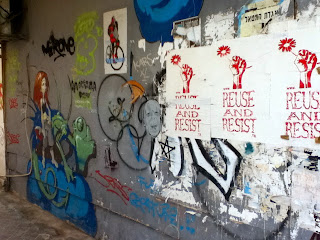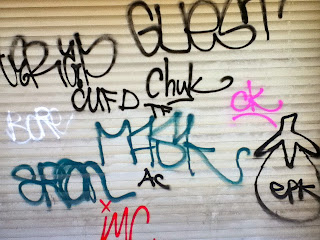Saturdays in Israel are a quiet affair.
Even in Tel Aviv, a secular enclave within the Holy Land, the Jewish day of rest takes on a special significance.
This Saturday I leave my friend Javin’s house, the scent of his couch and his cat still clinging to the clothes I slept in. I take a left out his door and walk down the shaded street. The branches overhead spill sunlight through their leaves in quiet, lazy dapples as I walk by decades of disparate urban planning and architectural style.
Another left and a quick right and I’m at the top of Shouk Carmel, the long, crowded market that services the heart of the city. I’m hungry. Ordinarily I like to spend my not-so-substantial food money at the shouk, where for $5 U.S. I can fill up on fresh fruit, nuts, cheese, pastries – whatever looks good today. But on Saturday the shouk is closed.
The stands are empty, the storefronts shuttered for the day. Their proprietors stay at home enjoying their one day of rest, whether or not it retains any holy value for them. Instead, the ghosts of yesterday’s spices linger in the air. The dusty sunlight that streams through the slanted metal roof overhead illuminates the rich reds and oranges that cling to the air and permanently infuse the space with the sweet smells native to this part of the world. Yesterday evening they were being hawked for 10 shekles a handful; tomorrow morning, the haggling will begin anew.
Walking through the market, a much-needed sense of calm washes me down. Tel Aviv is a loud city, much like the rest of Israel. People yell when they want your attention, they honk at you no matter what. Bikes ride people down on the sidewalk, clanging their bells sharply. Israel is brusque and uncouth, and Tel Aviv is the heart of that live-hard-and-fast lifestyle. It’s why I love this country.
Today, however, is quiet, for the first and only time in a week. In the morning, cars are rare sights, even on the busier thoroughfares. The ultra-orthodox can be seen walking home from synagogue. As they walk by the scantily clad hipster girls that also call this city home, the orthodox men turn their heads away, so as to not think impure thoughts. This culture clash between old and new is but one of the many you see everyday in this city – another example of a changing of the guard, a time of transition for Israel and her people. A country cannot live so divided, and people are beginning to get fed up.
Today, however, is quiet, for the first and only time in a week. In the morning, cars are rare sights, even on the busier thoroughfares. The ultra-orthodox can be seen walking home from synagogue. As they walk by the scantily clad hipster girls that also call this city home, the orthodox men turn their heads away, so as to not think impure thoughts. This culture clash between old and new is but one of the many you see everyday in this city – another example of a changing of the guard, a time of transition for Israel and her people. A country cannot live so divided, and people are beginning to get fed up.
The well-publicized protests of the summer are but one facet of this youth movement. The underpaid sub-culture finds many avenues for its voice, and in Tel Aviv, an enormous street art culture has emerged.
For forty minutes I walk back and forth down empty, winding roads, unsure of my direction but confident in my purpose – to find some trend in the graffiti I see, even if it is just on a single street. These are the voices of a culture that have previously gone unheard. Often as not the spray-painted messages are simple words or phrases. Other artists rely on enormous, detailed illustrations to get their point across.
But for all the dissidence inherent to graffiti culture and Israeli youth, the graffiti is done almost respectfully. Tel Aviv is a city of the 20th century, and its wealth has let its residents’ whims come to life. Nowhere is this more evident than in the buildings, where Bauhaus inspired rigidity sits next to Victorian townhouses and across the street a Brutalist-style post office hulks. This urban un-planning gives the city character. It also gives it a lot of dead, hideous buildings. These are what get tagged. Graffiti artists are amazingly respectful of new properties, of peoples’ homes. The pictures you see below are from shuttered storefronts, alleyways and abandoned office lots.
















































0 comments:
Post a Comment